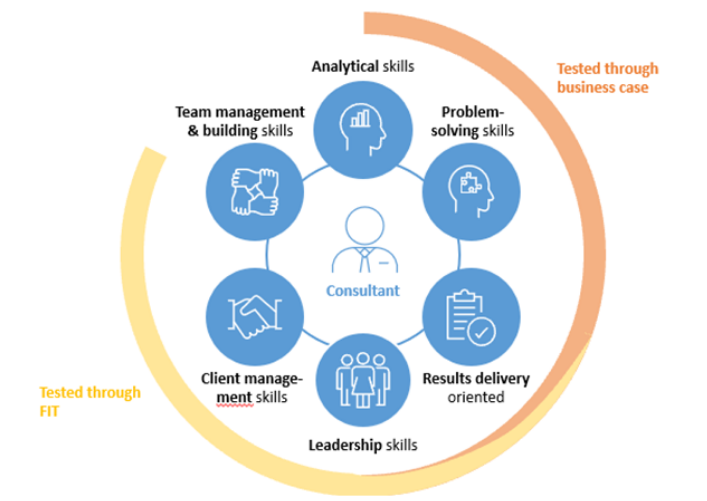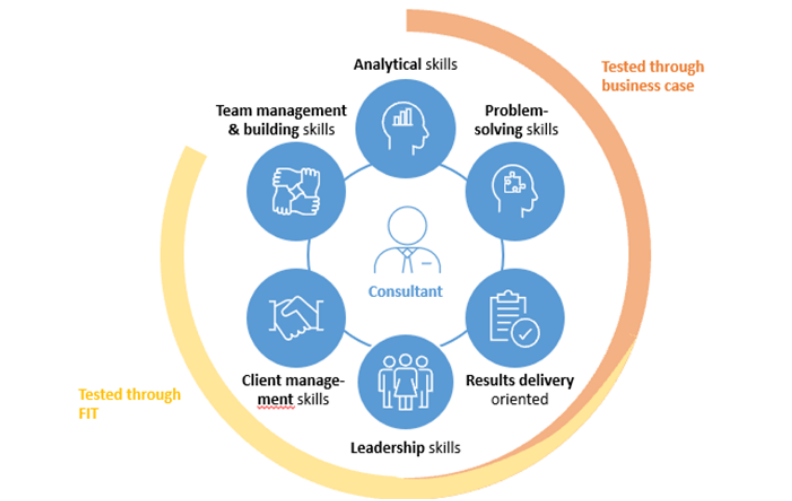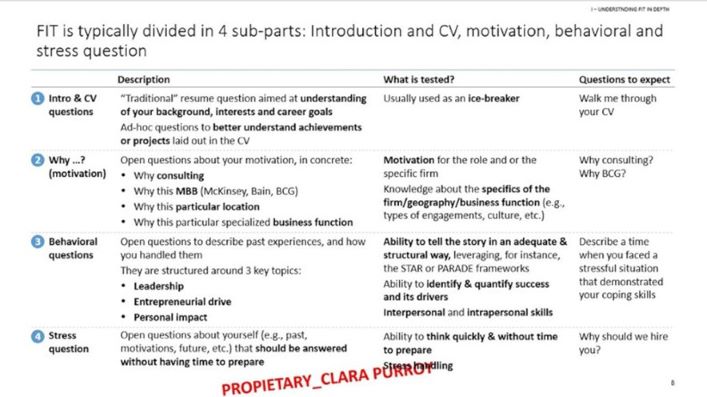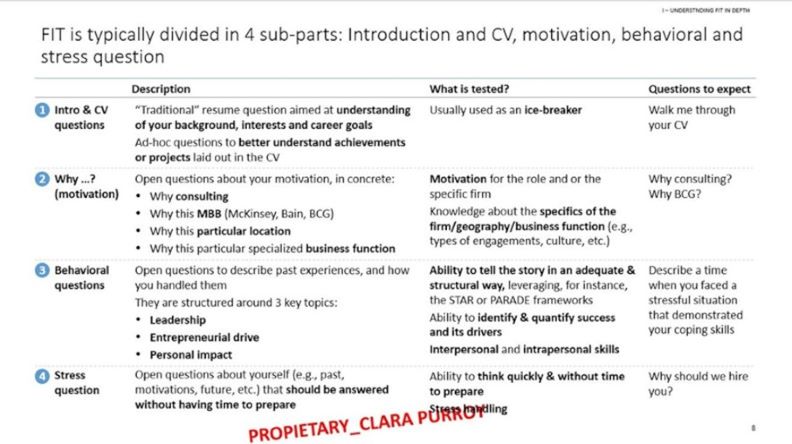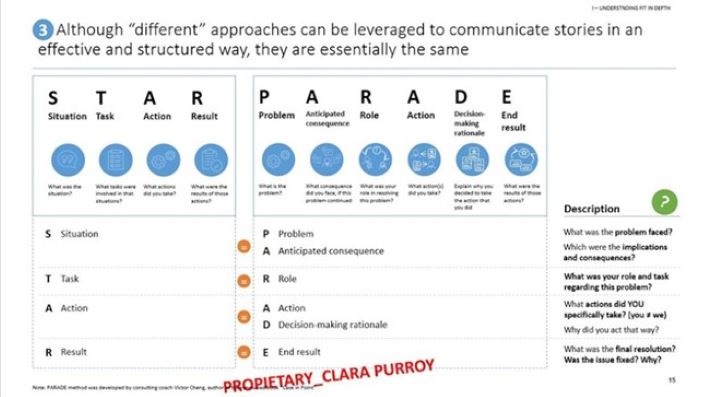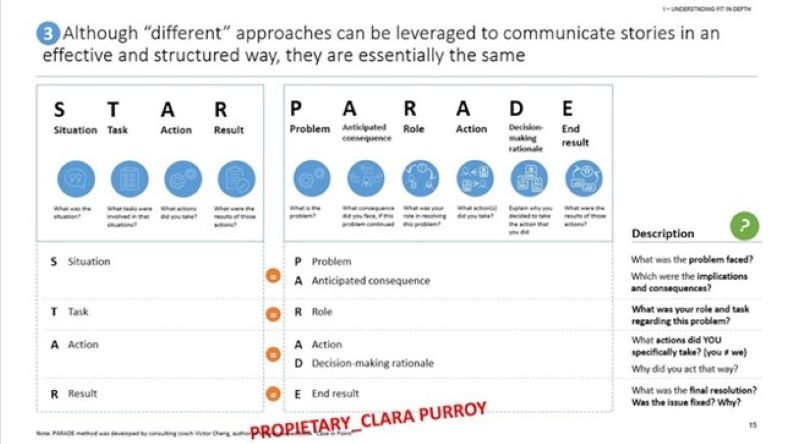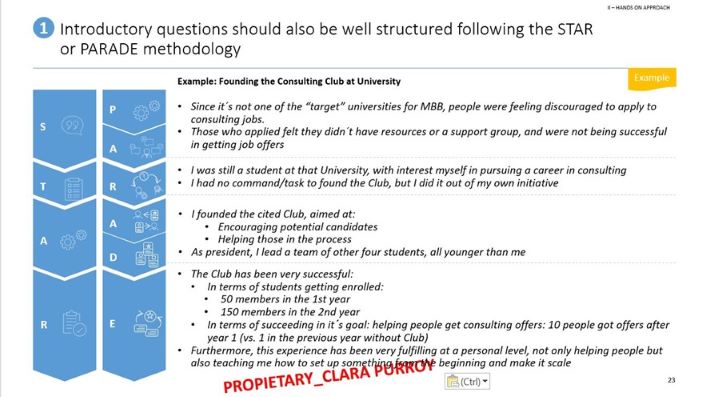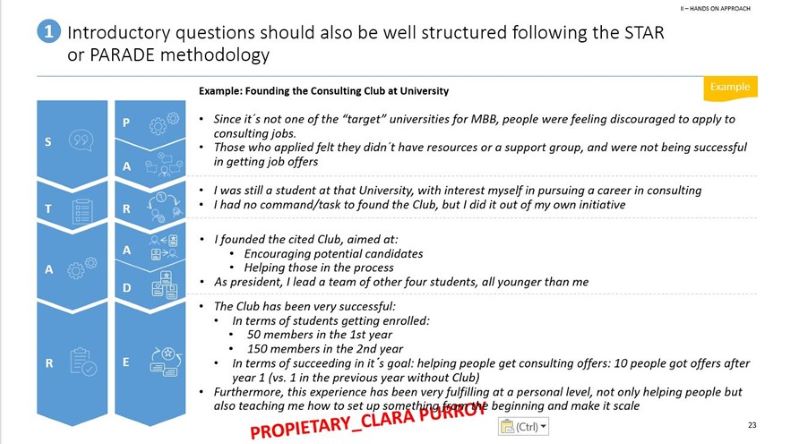Nutze Storytelling-Techniken (STAR- oder PARADE) zur strukturierten und effizienten Beantwortung von CV-Fragen.
STAR steht für:
- Situation → Task → Action → Result
(Situation → Aufgabe → Handlung → Ergebnis)
PARADE ist ähnlich aufgebaut, jedoch um zusätzliche Aspekte erweitert:
- Problem → Anticipated Consequence → Role → Action → Decision-Making Rationale → End Result
(Problem → Antizipierte Konsequenz → Rolle → Handlung → Entscheidungsfindung → Endergebnis)
Durch den Einsatz dieser Kommunikationstechniken kannst du deine Antworten effizient strukturieren, ohne von einem Gedanken zum nächsten springen zu müssen. Wenn du die STAR/PARADE-Technik verwendest, beginnst du mit dem Problem und seinen Implikationen und Konsequenzen. Danach beschreibst du deine Rolle und Aufgabe in Bezug auf dieses Problem. Der wichtigste Teil ist die Beschreibung der konkreten Maßnahmen, die du zur Lösung des Problems ergriffen hast. Abschließend erklärst du das Endergebnis und ob das Problem erfolgreich gelöst wurde – idealerweise mit einer kurzen Begründung.
➥ Grafiken aus dem „Integrated FIT Guide for MBB“
Allgemeine Tipps für die Beantwortung von Intro- und CV-Fragen
Strukturierte Antworten mit der STAR/PARADE-Methode:
- Beginne mit dem Problem und den daraus resultierenden Konsequenzen.
- Beschreibe deine Rolle und die Maßnahmen, die du persönlich zur Lösung beigetragen hast.
- Erkläre das Ergebnis deiner Maßnahmen und ob das gewünschte Ziel erreicht wurde.
Belege deine Geschichte mit konkreten Zahlen und Beispielen – je präziser, desto besser!
- Numerische KPIs: Versuche, dein Wirken mit messbaren Daten zu untermauern, um deine Antwort greifbarer und für den Interviewer nachvollziehbar zu machen.
- Nicht-numerische Datenpunkte: Diese sind ebenso wichtig, um den Kontext und die Auswirkungen deiner Arbeit verständlich zu machen.
Beispiel 1: „Führe mich durch deinen CV“
Hinweise:
Es gibt nicht „die eine richtige“ Art, den Interviewer durch deinen CV zu führen. Folgende Punkte helfen dir aber dabei, deine Antwort strukturiert und wirkungsvoll zu gestalten:
Sei strukturiert und folge wenn möglich einer bestimmten Reihenfolge:
- Option 1: Beginne mit der neuesten Erfahrung. Das ist sinnvoll, wenn deine letzte Position besonders relevant ist (gilt häufig für erfahrene Bewerber:innen).
- Option 2: Beginne mit deinem Studium und folge einer chronologischen Reihenfolge, um deine berufliche Entwicklung und Entscheidungen besser erklären zu können (gilt häufig für Berufseinsteiger:innen mit weniger relevanter Arbeitserfahrung).
Bleibe konsistent:
- Erwähne keine Punkte, die nicht im CV stehen (z. B. langfristige Karriereziele).
Kurzbeispiele für eine strukturierte CV-Vorstellung
- Für Absolvent:innen:
"Ich habe vor Kurzem mein Studium am Imperial College abgeschlossen und dort meinen Master in Management Engineering gemacht, mit einem Abschluss unter den Top 3 % meines Jahrgangs. Letzten Sommer habe ich ein Praktikum im Bereich Strategy Consulting absolviert." - Für erfahrene Bewerber:innen:
"Nach meinem Einstieg im Public Sector bin ich vor fünf Jahren zu einem Fortune-500-Unternehmen gewechselt, um eine praxisnähere Rolle mit klarem Fokus einzunehmen. In meiner letzten Position habe ich mich sowohl fachlich als auch persönlich stark weiterentwickelt und festgestellt, dass mich insbesondere das Thema People Management begeistert – sowohl im Umgang mit jüngeren Kolleg:innen als auch mit Kund:innen. Daher möchte ich in das Consulting wechseln, um mich in diesem Bereich weiterzuentwickeln und gleichzeitig einen größeren Impact auf bedeutende Projekte zu haben."
Detailliertes Beispiel 2: „Erzähl mir etwas über dich”
Hinweise:
- Anders als bei einer klassischen CV-Zusammenfassung musst du nicht alle Abschnitte erwähnen oder chronologisch vorgehen.
- Indem du nur bestimmte Meilensteine aus deinem CV ansprichst, zeigst du, was dich ausmacht – nicht nur, was du bisher gemacht hast.
- Erwähne auch, was dich antreibt und begeistert: Diese Frage gibt dir die Möglichkeit, die „Fakten“ aus deinem CV mit deiner Motivation zu verknüpfen.
- Falls du deine:n Interviewer:in im Voraus recherchieren konntest (was in der Regel nur bei Bain möglich ist) und Gemeinsamkeiten findest, bringe sie ein, wenn sie relevant sind.
Beispiel:
“Strategie hat mich schon immer fasziniert. Bereits während meiner Schulzeit habe ich meine Sommer damit verbracht, meiner Mutter im Familienunternehmen – einem mittelständischen Einzelhändler – zu helfen. Mit der Zeit habe ich gemerkt: Es war nicht der Einkauf oder das Produktmanagement, das mich wirklich begeistert hat, sondern die strategische Ausrichtung des Unternehmens. Ich liebe es, Analysen durchzuführen, Pläne zu entwickeln und Maßnahmen umzusetzen, die echten Mehrwert schaffen.
Deshalb stand für mich früh fest, dass ich ins Strategie-Consulting möchte – weil ich dort kontinuierlich dazulernen kann, um Unternehmen gezielt voranzubringen.”
Detailliertes Beispiel 3: „Auf welche Leistung in deinem CV bist du besonders stolz?”
Hinweise
- Sei präzise: Wähle nicht einfach einen gesamten Lebensabschnitt, sondern ein konkretes Ereignis oder Projekt (z. B. ein bestimmtes Projekt statt eines gesamten zweijährigen Jobs).
- Sei darauf vorbereitet, es ähnlich wie eine Story in einem Behavioral-Interview zu präsentieren – idealerweise mit der STAR- oder PARADE-Methode (aber kürzer: 1–2 Minuten statt 10–12 Minuten).
Beispiel
“Ich bin besonders stolz darauf, den Consulting Club an meiner Universität gegründet zu haben. Da meine Uni nicht zu den „Target Universities“ für MBB gehört, waren viele Studierende entmutigt, sich zu bewerben, und diejenigen, die es taten, fühlten sich oft nicht ausreichend vorbereitet oder unterstützt.
Deshalb habe ich vor zwei Jahren den Club ins Leben gerufen – mit dem Ziel, potenzielle Kandidat:innen zu ermutigen und Bewerber:innen gezielt zu unterstützen. Der Erfolg war enorm: Im ersten Jahr hatten wir 50 Mitglieder, im zweiten Jahr waren es bereits 150. Zudem erhielten nach dem ersten Jahr zehn Studierende ein Angebot – im Vergleich zu nur einer Person im Jahr davor.
Für mich war dieses Projekt nicht nur eine großartige Möglichkeit, anderen zu helfen, sondern auch eine wertvolle persönliche Erfahrung. Ich habe gelernt, wie man eine Initiative von Grund auf aufbaut und skaliert – und das macht diese Erfahrung für mich besonders wertvoll.”
Wie du deine Antwort nach der STAR- oder PARADE-Methode aufbaust, zeigt dir folgende Übersicht noch einmal genauer:

